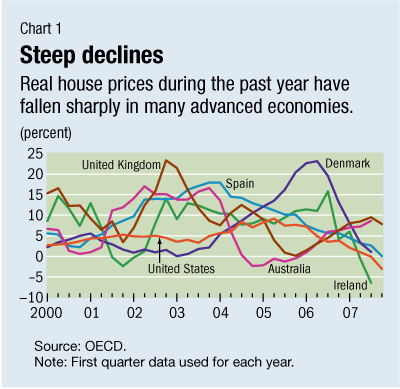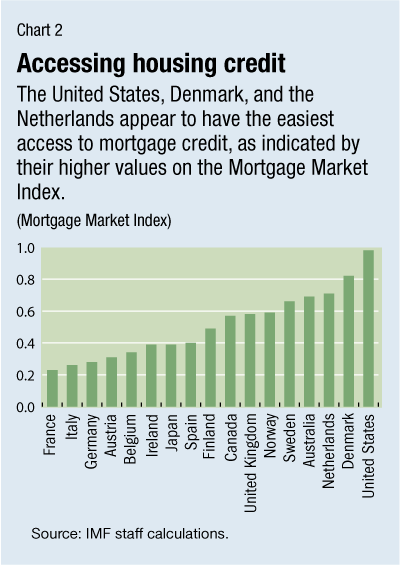
Typical street scene in Santa Ana, El Salvador. (Photo: iStock)
IMF Survey: Managing Housing Sector Boom-Bust Cycles
April 3, 2008
- U.S. house prices falling sharply, starting slide in other advanced economies
- Housing sector spillovers stronger in more developed mortgage markets
- May need aggressive monetary policy response to unusual house price trends
After several years of rapid price increases, the housing markets are turning down in several advanced economies, according to new IMF research.

In real terms, house price growth has decelerated in many countries, and in a few of them real house prices have fallen during the past year (photo: Newscom)
WORLD ECONOMIC OUTLOOK
Published in an analytic chapter of the April 2008 World Economic Outlook, entitled "The Changing Housing Cycle and Its Implications for Monetary Policy," the research shows that house price growth has decelerated in many countries.
In a few countries—the United States and Ireland—house prices have fallen during the past year (see Chart 1). Real residential investment has also slowed in several countries, particularly in the United States, Australia, and, especially, Ireland, where it has fallen by about 3 percentage points of GDP since its peak four years ago.
Housing sector and the business cycle
Although few people would disagree that such developments may have important implications for the level of economic activity, considerable uncertainty still exists about the link between the housing sector and the business cycle. In particular, there are varying estimates of and analyses on the extent to which house price fluctuations affect consumer spending and the dynamics of residential investment.

The uncertainty has been compounded by dramatic changes over the past two decades in how housing is financed in several advanced economies. These changes have entailed a shift toward a more competitive housing finance model. The new model has made it easier for households to access housing-related credit through diverse funding sources, lender types, and loan products, contributing to the rapid growth of mortgage debt in a number of countries.
Moreover, the prospect of a sharp boom-bust cycle in the housing sector in several advanced economies has reignited the debate on how monetary policy, which seeks to influence inflation outcomes by raising or lowering interest rates, should respond to developments in the housing sector.
Cross-country differences
In our study, we investigate whether the changes in the systems of housing finance over the past two decades have altered the links between the housing sector and economic activity. We also explore the implications of housing sector developments for the conduct of monetary policy. In particular, we aim to answer two questions:
• Are cross-country differences in the role of the housing sector in the business cycle and in the channels through which monetary policy is transmitted related to differences in mortgage markets?
• Have financial innovations changed the way monetary policy should respond to developments in the housing sector?
Our research shows that significant cross-country differences exist in mortgage contracts. We find that the United States, Denmark, the Netherlands, Australia, and Sweden appear to have the most "developed" mortgage markets, which allow households greater access to housing-related financing, whereas households in continental Europe tend to have more limited access to such financing (see Chart 2).

We also find that the spillovers from the housing sector to the rest of the economy are larger in economies where it is easier to access mortgage credit and use homes as collateral.This is because movements in house prices influence household spending plans through the role of housing as collateral—for example, increases in house prices raise the value of the collateral available to households, loosen borrowing constraints, and support spending.
Transmitting monetary policy
Can monetary policy smooth the impact on the broader economy of developments in the housing markets? Some observers have raised doubts as to whether this is still the case, because greater integration of mortgage markets with the rest of the financial system may have reduced the importance of mortgage credit availability as a channel of monetary policy transmission.
However, we find that financial deregulation may have strengthened the role of housing in monetary policy transmission, because easier access to housing collateral may have linked house prices more closely to monetary policy. We also find that the effects of monetary policy changes on output are larger in those economies where housing finance markets are relatively more developed and competitive.
More aggressive stance
Based on these findings, we suggest that the response of monetary policy to changes in the housing sector should vary depending on the level of development of mortgage markets.
In particular, we conclude that economies with more developed mortgage markets could become more economically stable by pursuing a monetary policy approach that responds to house price movements, particularly when they are unusually rapid or lead prices away from past relationships with fundamentals, in addition to consumer price inflation and the output gap (that is, the difference between potential GDP and actual GDP, or output). But this approach must be followed within a broader risk management framework that recognizes the uncertainty over the factors driving house price dynamics and their impact on the economy.
Paying attention to house price developments does not require changing the existing monetary policy approaches. Rather, these approaches should be interpreted in a more flexible manner, for example, by extending the time horizon over which inflation and output are returned to target. However, it is important that such an approach be applied symmetrically. An aggressive easing would be justified in response to concerns from a rapid slowdown of the housing sector, but some "leaning against the wind" may also prove useful to limit the risk of a buildup of housing market and financial imbalances.
Finally, it is important to recognize that monetary policy must be complemented by regulatory policies to limit risks of unsustainable house price bubbles because of imprudent lending practices.
Comments on this article should be sent to imfsurvey@imf.org


